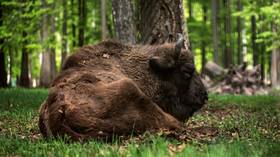Poland threatening Europe’s largest native animal – Belarus

The Polish government is undermining a century-long conservation project, which has brought the European bison back from the brink of extinction, the Belarusian Foreign Ministry has claimed in a statement released by state media.
The message marked the upcoming centennial of a gathering in Paris, where environmentalists set out to restore the then-extinct wild population of the continent's largest animal. In 1923 the International Conservation of Nature Congress in France launched a restitution program for bison in the Belovezhsky (Bialowieza) Forest, a vast woodland on what is now the Polish-Belarusian border.
The last freely-roaming member of the species was hunted down just six years later in the Caucasus mountains. Every European bison that currently exists traces its lineage to just 54 animals, who were kept in zoos and private collections. Those come from just 12 founder ancestors.
Warsaw’s 2021 decision to erect a border fence through the Belovezhsky Forest “inevitably leads to isolation of population groups and weakens the genome of an already genetically vulnerable species,” Belarusian diplomats said. They warned that unless the problem is addressed, nations may have to call a new international summit on bison conservation “in a couple of decades.”
Na granicy polsko-białoruskiej rozpoczęliśmy już budowę siatki chroniącej zwierzęta przed okaleczeniem. Siatka powstaje po obu stronach ogrodzenia. pic.twitter.com/rUFZS0fTAJ
— Mariusz Błaszczak (@mblaszczak) September 5, 2021
The Polish government erected a barbed wire fence along the Belarusian border in 2021, when hundreds of would-be asylum-seekers, mostly from the Middle East, sought to enter the EU via Belarus in what the EU claimed to be a Minsk-orchestrated pressure campaign. Poland, Lithuania, and Latvia, the three member states directly affected by the influx, responded with a heavy-handed approach.
Environmental activists urged Poland not to divide the Belovezhsky Forest with the fence, saying it would harm the local wildlife. Warsaw agreed to add additional nets to the razor wire to protect animals from hurting themselves. It also said there would be gaps in the fence to facilitate animal crossings.
The forest is the largest habitat for European bison, with some 1,400 animals estimated to be living there, according to Minsk. At its estimated peak in the 19th century, the population reached some 1,800. Around 7,500 European bison exist in the world today, with roughly 4,000 of them in the wild, according to the conservation group Rewilding Europe.












